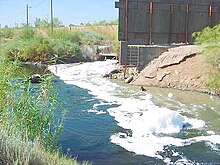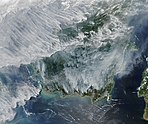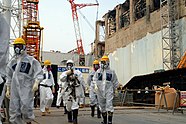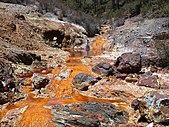Environmental issues
The examples and perspective in this article may not represent a worldwide view of the subject. (March 2020) |

Environmental issues are disruptions in the usual function of ecosystems.[1] Further, these issues can be caused by humans (human impact on the environment)[2] or they can be natural. These issues are considered serious when the ecosystem cannot recover in the present situation, and catastrophic if the ecosystem is projected to certainly collapse.
Environmental protection is the practice of protecting the natural environment on the individual, organizational or governmental levels, for the benefit of both the environment and humans. Environmentalism is a social and environmental movement that addresses environmental issues through advocacy, legislation education, and activism.[3]
Environment destruction caused by humans is a global, ongoing problem.
Types
Major current environmental issues may include
Human impact
- Top-left: Satellite image of Southeast Asian haze.
- Top-right: Fukushima disaster.
- Middle-left: a picture from 1997 of industrial fishing, a practice that has led to overfishing.
- Middle-right: a seabird during an oil spill.
- Bottom-left: Acid mine drainage in the Rio Tinto.
- Bottom-right: depiction of Atlantic forestby Portuguese settlers, c. 1820–25.
| Part of a series on |
| Sociology |
|---|
 |
Human impact on the environment (or anthropogenic environmental impact) refers to changes to
Degradation
Environmental degradation is one of the ten threats officially cautioned by the
Conflict
| Part of a series on |
| Environmental justice |
|---|
|
|

Environmental conflicts, socio-environmental conflict or ecological distribution conflicts (EDCs) are social conflicts caused by environmental degradation or by unequal distribution of environmental resources.[43][44][45] The Environmental Justice Atlas documented 3,100 environmental conflicts worldwide as of April 2020 and emphasised that many more conflicts remained undocumented.[43]
Parties involved in these conflicts include locally affected communities, states, companies and investors, and social or environmental movements;[46][47] typically environmental defenders are protecting their homelands from resource extraction or hazardous waste disposal.[43] Resource extraction and hazardous waste activities often create resource scarcities (such as by overfishing or deforestation), pollute the environment, and degrade the living space for humans and nature, resulting in conflict.[48] A particular case of environmental conflicts are forestry conflicts, or forest conflicts which "are broadly viewed as struggles of varying intensity between interest groups, over values and issues related to forest policy and the use of forest resources".[49] In the last decades, a growing number of these have been identified globally.[50]
Frequently environmental conflicts focus on
Costs
This section needs expansion. You can help by adding to it. (October 2016) |
Action
Justice
The movement began in the United States in the 1980s. It was heavily influenced by the American civil rights movement and focused on environmental racism within rich countries. The movement was later expanded to consider gender, international environmental injustice, and inequalities within marginalised groups. As the movement achieved some success in rich countries, environmental burdens were shifted to the Global South (as for example through extractivism or the global waste trade). The movement for environmental justice has thus become more global, with some of its aims now being articulated by the United Nations. The movement overlaps with movements for Indigenous land rights and for the human right to a healthy environment.[56]
The goal of the environmental justice movement is to achieve agency for marginalised communities in making environmental decisions that affect their lives. The global environmental justice movement arises from local environmental conflicts in which environmental defenders frequently confront multi-national corporations in resource extraction or other industries. Local outcomes of these conflicts are increasingly influenced by trans-national environmental justice networks.[57][58]
Environmental justice scholars have produced a large interdisciplinary body ofThe 2023 IPCC report highlighted the disproportionate effects of climate change on vulnerable populations. The report's findings make it clear that every increment of global warming exacerbates challenges such as extreme heatwaves, heavy rainfall, and other weather extremes, which in turn amplify risks for human health and ecosystems. With nearly half of the world's population residing in regions highly susceptible to climate change, the urgency for global actions that are both rapid and sustained is underscored. The importance of integrating diverse knowledge systems, including scientific, Indigenous, and local knowledge, into climate action is highlighted as a means to foster inclusive solutions that address the complexities of climate impacts across different communities.[61]
In addition, the report points out the critical gap in adaptation finance, noting that developing countries require significantly more resources to effectively adapt to climate challenges than what is currently available. This financial disparity raises questions about the global commitment to equitable climate action and underscores the need for a substantial increase in support and resources. The IPCC's analysis suggests that with adequate financial investment and international cooperation, it is possible to embark on a pathway towards resilience and sustainability that benefits all sections of society.[61]
Law
Assessment
Movement

The
Organizations
Environmental issues are addressed at a regional, national or international level by government organizations.
The largest international agency, set up in 1972, is the
Film and television
There are an increasing number of films being produced on environmental issues, especially on
See also
- Citizen science
- Ecotax
- Environmental impact statement
- Index of environmental articles
- Triple planetary crisis
Issues
- List of environmental issues (includes mitigation and conservation)
Specific issues
- Environmental impact of agriculture
- Environmental impact of aviation
- Environmental impact of reservoirs
- Environmental impact of the energy industry
- Environmental impact of fishing
- Environmental impact of irrigation
- Environmental impact of mining
- Environmental impact of paint
- Environmental impact of paper
- Environmental impact of pesticides
- Environmental implications of nanotechnology
- Environmental impact of shipping
- Environmental impact of war
References
- ISBN 978-0-12-822976-7
- ^ "Human Impacts on the Environment". education.nationalgeographic.org. Retrieved 2023-05-06.
- ISBN 978-1439847664.
- ^ McNeill, Z. Zane (2022-09-07). "Humans Destroying Ecosystems: How to Measure Our Impact on the Environment". Retrieved 2023-05-06.
- ^ "Marine Pollution". education.nationalgeographic.org. Retrieved 2023-05-06.
- ^ Alberro, Heather (28 January 2020). "Why we should be wary of blaming 'overpopulation' for the climate crisis". The Conversation. Retrieved 2020-12-31.
- ^ "David Attenborough's claim that humans have overrun the planet is his most popular comment". www.newstatesman.com. 4 November 2020. Retrieved 2021-08-03.
- ^ "Dominic Lawson: The population timebomb is a myth The doom-sayers are becoming more fashionable just as experts are coming to the view it has all been one giant false alarm". The Independent. UK. 18 January 2011. Retrieved 30 November 2011.
- S2CID 154132383.
- S2CID 149413363.
- S2CID 181366798.
- ^ Environment, U. N. (2021-02-11). "Making Peace With Nature". UNEP - UN Environment Programme. Retrieved 2022-02-18.
- ^ "SDGs will address 'three planetary crises' harming life on Earth". UN News. 2021-04-27. Retrieved 2022-02-18.
- ^ doi:10.7930/J0DJ5CTG.
- ^ Sahney, Benton & Ferry (2010); Hawksworth & Bull (2008); Steffen et al. (2006) Chapin, Matson & Vitousek (2011)
- Wired.com. Archivedfrom the original on 18 December 2019. Retrieved 24 November 2017.
- hdl:1808/30278. Archivedfrom the original on 3 January 2020. Retrieved 8 November 2019.
Still increasing by roughly 80 million people per year, or more than 200,000 per day (figure 1a–b), the world population must be stabilized—and, ideally, gradually reduced—within a framework that ensures social integrity. There are proven and effective policies that strengthen human rights while lowering fertility rates and lessening the impacts of population growth on GHG emissions and biodiversity loss. These policies make family-planning services available to all people, remove barriers to their access and achieve full gender equity, including primary and secondary education as a global norm for all, especially girls and young women (Bongaarts and O'Neill 2018).
- .
The consensus that humans are causing recent global warming is shared by 90%–100% of publishing climate scientists according to six independent studies
- hdl:10871/132650.
- Epa.gov. United States Environmental Protection Agency. 30 August 2016. Archivedfrom the original on 23 June 2011. Retrieved 23 November 2017.
Carbon dioxide is added to the atmosphere whenever people burn fossil fuels. Oceans play an important role in keeping the Earth's carbon cycle in balance. As the amount of carbon dioxide in the atmosphere rises, the oceans absorb a lot of it. In the ocean, carbon dioxide reacts with seawater to form carbonic acid. This causes the acidity of seawater to increase.
- ISBN 0-385-46809-1
- PMID 26601195.
- (PDF) from the original on 7 January 2020. Retrieved 15 December 2016.
The overarching driver of species extinction is human population growth and increasing per capita consumption.
- S2CID 250387801.
- ^ Perkins, Sid (11 July 2017). "The best way to reduce your carbon footprint is one the government isn't telling you about". Science. Archived from the original on 1 December 2017. Retrieved 29 November 2017.
- PMID 32294098.
It is well understood that adding to the population increases CO2 emissions.
- ISBN 978-0199283279.
- S2CID 209502532.
the neoliberal paradigm contributes significantly to planetary unraveling. Neoliberal thinking treats the economy and the ecosphere as separate independent systems and essentially ignores the latter.
- .
- S2CID 247433264.
Conservation biologists agree that humanity is on the verge of causing a mass extinction and that its primary driver is our immense and rapidly expanding global economy.
- ^ "New Climate Risk Classification Created to Account for Potential "Existential" Threats". Scripps Institution of Oceanography. 14 September 2017. Archived from the original on 15 September 2017. Retrieved 24 November 2017.
A new study evaluating models of future climate scenarios has led to the creation of the new risk categories "catastrophic" and "unknown" to characterize the range of threats posed by rapid global warming. Researchers propose that unknown risks imply existential threats to the survival of humanity.
- Thebulletin.org. Taylor & Francis. Archivedfrom the original on 13 April 2016. Retrieved 24 November 2017.
- ISBN 0412740508.
- ^ Crutzen, Paul and Eugene F. Stoermer. "The 'Anthropocene'" in International Geosphere-Biosphere Programme Newsletter. 41 (May 2000): 17–18
- ^ Scott, Michon (2014). "Glossary". NASA Earth Observatory. Archived from the original on 17 September 2008. Retrieved 3 November 2008.
- S2CID 222415797.
- S2CID 228077506.
- S2CID 135104338.
- .
- .
- ^ "Environmental Degradation - an overview | ScienceDirect Topics". www.sciencedirect.com. Retrieved 2024-03-08.
- ^ "ISDR : Terminology". The International Strategy for Disaster Reduction. 2004-03-31. Retrieved 2010-06-09.
- ^ PMID 32801483.
- S2CID 198051009.
- ^ a b Libiszewski, Stephan (1991). "What is an Environmental Conflict?" (PDF). Journal of Peace Research. 28 (4): 407–422.
- .
- .
- ^ ISBN 978-1-84826-010-8.
- OCLC 47207066.
- .
- S2CID 156535916.
- ^ "Environment, Conflict and Peacebuilding". International Institute for Sustainable Development. Retrieved 2022-02-18.
- ISSN 1751-9020.
- ^ a b Schlosberg, David. (2007) Defining Environmental Justice: Theories, Movements, and Nature. Oxford University Press.
- S2CID 198588483.
- ISBN 978-1-84376-548-6.
- PMID 32801483.
- S2CID 156535916.
- ISBN 0-534-42039-7.
- ISBN 978-1-4798-9456-7.
- ^ a b "Urgent climate action can secure a liveable future for all — IPCC". Retrieved 2024-02-26.
- ^ Phillipe Sands (2003) Principles of International Environmental Law. 2nd Edition. p. xxi Available at [1] Accessed 19 February 2020
- ^ "What is Environmental Law? | Becoming an Environmental Lawyer". Retrieved 2023-06-28.
- ^ "NOUN | National Open University of Nigeria". nou.edu.ng. Retrieved 2023-06-29.
- ^ MacKinnon, A. J., Duinker, P. N., Walker, T. R. (2018). The Application of Science in Environmental Impact Assessment. Routledge.
- ISBN 978-1439828731
- ^ Caves, R. W. (2004). Encyclopedia of the City. Routledge. p. 227.
- ^ "Principle of Environmental Impact Assessment Best Practice" (PDF). International Association for Impact Assessment. 1999. Archived from the original (PDF) on May 7, 2012. Retrieved September 15, 2020.
- ^ Holder, J., (2004), Environmental Assessment: The Regulation of Decision Making, Oxford University Press, New York; For a comparative discussion of the elements of various domestic EIA systems, see Christopher Wood Environmental Impact Assessment: A Comparative Review (2 ed, Prentice Hall, Harlow, 2002).
- ISBN 978-0-253-20660-2. Archivedfrom the original on 8 April 2023. Retrieved 8 April 2023.
- from the original on 5 March 2023. Retrieved 8 April 2023.
- ^ "About". IUCN. 2014-12-03. Retrieved 2017-05-20.
Works cited
- Chapin, F. Stuart; Matson, Pamela A.; Vitousek, Peter (September 2, 2011). Principles of Terrestrial Ecosystem Ecology. Springer Science+Business Media. ISBN 978-1-4419-9504-9. Retrieved October 4, 2022.
- Hawksworth, David L.; Bull, Alan T. (2008). Biodiversity and Conservation in Europe. Springer. p. 3390. ISBN 978-1402068645.
- Sahney, S.; Benton, M.J.; Ferry, P.A. (2010). "Links between global taxonomic diversity, ecological diversity and the expansion of vertebrates on land". Biology Letters. 6 (4): 544–547. PMID 20106856.
- Steffen, Will; Sanderson, Regina Angelina; Tyson, Peter D.; Jäger, Jill; Matson, Pamela A.; Moore III, Berrien; Oldfield, Frank; Richardson, Katherine; Schellnhuber, Hans-Joachim (January 27, 2006). Global Change and the Earth System: A Planet Under Pressure. Springer Science+Business Media. ISBN 978-3-540-26607-5. Retrieved October 4, 2022.
- Ferguson, Robert (1999). Environmental Public Awareness Handbook: Case Studies and Lessons Learned in Mongolia. Ulaanbaatar: DSConsulting. ISBN 99929-50-13-7.
External links
 Media related to Environmental problems at Wikimedia Commons
Media related to Environmental problems at Wikimedia Commons






